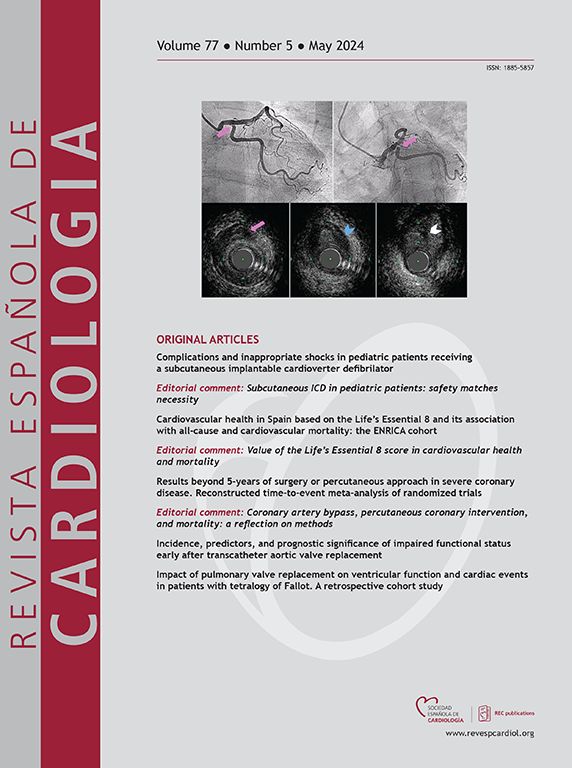根据VARC-3标准进行免疫接种后的早期安全性:发病率、预测因素和临床影响
IF 5.9
2区 医学
Q2 Medicine
引用次数: 0
摘要
瓣膜学术研究联盟(VARC)-3对经导管主动脉瓣置换术(TAVR)后早期安全性(ES)复合终点的定义缺乏临床验证。本研究的目的是根据VARC-3标准确定TAVR后ES的发生率、预测因素和临床影响。方法我们进行了一项多中心研究,包括10,078例经动脉TAVR的严重主动脉瓣狭窄患者。根据VARC-3标准,30天的ES被定义为无全因死亡、卒中、VARC 2-4型出血、主要血管、通道相关或心脏结构并发症、急性肾损伤3-4期、中度或重度主动脉反流、新的永久性起搏器植入、以及与该装置相关的手术或干预。基线、程序和随访数据前瞻性地收集在专用数据库中。结果6598例(65.5%)患者获得治疗。与ES缺乏相关的主要因素是2-4型出血(18.9%)和新起搏器植入(13.6%)。高龄、外周动脉疾病、慢性肾脏疾病和球囊扩张后与无es风险增加相关(P <;.01)。未能实现ES与TAVR术后1年内较高的全因死亡率相关(HR, 3.17;95%置信区间,2.76 - -3.65;P & lt;措施)。结论:多达三分之一的当代TAVR患者没有达到varc -3 ES,这与较差的中期预后相关。与风险增加相关的因素是高龄、基线合并症和一些手术特征(扩张后)。这些发现强调了继续努力减少tavr相关手术并发症风险的重要性。本文章由计算机程序翻译,如有差异,请以英文原文为准。
Seguridad precoz tras TAVI según los criterios VARC-3: incidencia, predictores e impacto clínico
Introduction and objectives
The Valve Academic Research Consortium (VARC)-3 definition of the early safety (ES) composite endpoint after transcatheter aortic valve replacement (TAVR) lacks clinical validation. The aim of this study was to determine the incidence, predictors, and clinical impact of ES after TAVR as defined by VARC-3 criteria.
Methods
We performed a multicenter study including 10 078 patients with severe aortic stenosis undergoing transarterial TAVR. According to VARC-3 criteria, ES at 30 days was defined as freedom from all-cause mortality, stroke, VARC type 2-4 bleeding, major vascular, access-related, or cardiac structural complications, acute kidney injury stages 3-4, moderate or severe aortic regurgitation, new permanent pacemaker implantation, and surgery or intervention related to the device. Baseline, procedural, and follow-up data were prospectively collected in a dedicated database.
Results
ES was achieved in 6598 patients (65.5%). The main factors associated with a lack of ES were the occurrence of type 2-4 bleeding (18.9%), and new pacemaker implantation (13.6%). Advanced age, peripheral artery disease, chronic kidney disease, and balloon postdilation were associated with an increased risk of no-ES (P < .01 for all). Failure to achieve ES was associated with higher all-cause mortality up to 1-year after TAVR (HR, 3.17; 95%CI, 2.76-3.65; P < .001).
Conclusions
VARC-3 ES was not achieved in up to one-third of contemporary TAVR patients, which was associated with worse mid-term outcomes. The factors associated with increased risk were advanced age, baseline comorbidities, and some procedural features (postdilation). These findings highlight the importance of continued efforts to minimize the risk of TAVR-related procedural complications.
求助全文
通过发布文献求助,成功后即可免费获取论文全文。
去求助
来源期刊

Revista espanola de cardiologia
医学-心血管系统
CiteScore
4.20
自引率
13.60%
发文量
257
审稿时长
28 days
期刊介绍:
Revista Española de Cardiología, Revista bilingüe científica internacional, dedicada a las enfermedades cardiovasculares, es la publicación oficial de la Sociedad Española de Cardiología.
 求助内容:
求助内容: 应助结果提醒方式:
应助结果提醒方式:


